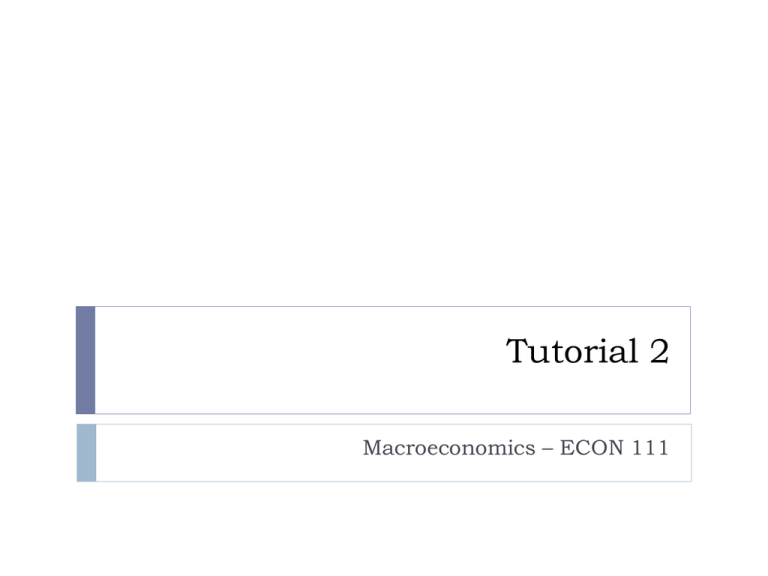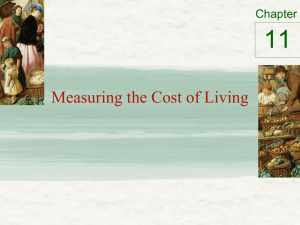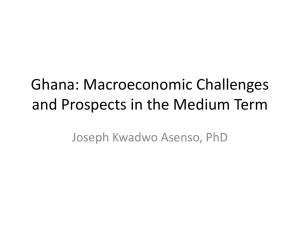Tutorial 2
advertisement

Tutorial 2 Macroeconomics – ECON 111 The consumers price index (CPI) is a measure of the overall cost of the goods and services bought by a typical household. Statistics NZ identifies a market basket of goods and services the typical consumer buys. Question 1 The GDP Deflator and the Consumer Price Index (CPI) are both tools used by economists to measure how quickly prices rise in an economy, as both statistics indicate the rate at which prices of goods and services rise. Examine whether this is an accurate description of the GDP Deflator and CPI or whether there are important differences that may cause them to diverge. Both the GDP deflator and the CPI measure how quickly prices are rising in an economy, and therefore both these statistics tell a similar story to some extent. However there are a few differences between the two, and the first of them is that the GDP deflator reflects the prices of all goods and services produced domestically, some of which are not in the CPI basket of goods. The CPI reflects the cost of a basket of goods and services that are bought by a typical consumer, therefore will contain some things not in the GDP deflator, e.g. goods produced overseas. The second difference between the two statistics is that the GDP deflator compares the prices of currently produced goods and services in the base year, while the CPI compares the price of a fixed basket of goods in different years. Question 1 State whether a hundred percent (100%) price increase in New Zealand of Caviar and Sirloin Steaks would lead to an increase in the CPI than a 10% price increase in bread. Give reasons to support your answer. A 10% increase in the price of bread will have a greater impact on the CPI than any percent increase in the price of caviar and sirloin steaks. Bread is a bigger part of the average consumer's market basket. This is because caviar and sirloin steaks are not consumed by the typical consumer, hence not in the CPI. When constructing the basket, Statistics New Zealand tries to include goods and services most frequently used by the average consumer, weighted by how much consumers use each item. Question 1 Explain clearly, using appropriate examples why the CPI of a country can be overstated, and how such an overstated figure can be a problem to the implementation of government policy in regard to inflation. The CPI of a country is very likely to be overstated due to substitution bias, the introduction of new goods, and the improved quality of goods, which cannot be captured by the CPI statistic as it uses a fixed basket of goods. It is accepted that the CPI is normally overstated by an amount of 0.5-1.5%. Government policies in regard to welfare payments, superannuation and even wages are tied to the CPI, and automatically raised each year in line with any increase in the CPI. Question 2 The following table shows the prices and the quantities consumed in the country known as ‘Nannystate’. The base year is 2007 as it was used to determine the typical consumption basket for the economy. Price of Qty of Price of Qty of Price of Qty of Books Books Pencils Pencils Pens Pens 2007 $50 10 $1 100 $5 100 2008 $50 12 $1 200 $10 50 2009 $60 12 $1.50 250 $20 20 Year Question 2 (a) Calculate the CPI (Consumer Price Index) in 2007, 2008 and 2009. (b) Calculate the inflation rate in 2008 and 2009. (c) What type of bias do you observe in the CPI and corresponding inflation rates you generated above? Give reasons for your answer. (d) If there was a COLA (Cost of Living Allowance) clause in the wage contract of people in this country, explain briefly based on the CPI figures calculated by you whether the standard of living of people in this country is likely to increase, decrease or stay the same over the years, 2007 to 2009? Give reasons for your answer. (e) Again, suppose there was a COLA clause in the wage contract based on the CPI calculated above. If a person only consumes pens (no paper or pencils) would his standard of living likely increase, decrease, or stay the same over the years 2007 – 2009? Explain. (f) “Economists use both the GDP deflator and the CPI as a measure of prevailing inflation in a country. However, there are important differences Question 2 (a) Calculate the CPI (Consumer Price Index) in 2007, 2008 and 2009. (b) Calculate the inflation rate in 2008 and 2009. (c) What type of bias do you observe in the CPI and corresponding inflation rates you generated above? Give reasons for your answer. Question 2 (a) Calculate the CPI (Consumer Price Index) in 2007, 2008 and 2009. (b) Calculate the inflation rate in 2008 and 2009. Inflation rate 2008 = 45.5% Inflation rate 2009 = 71.8% (c) What type of bias do you observe in the CPI and corresponding inflation rates you generated above? Give reasons for your answer. (d) If there was a COLA (Cost of Living Allowance) clause in the wage contract of people in this country, explain briefly based on the CPI figures calculated by you whether the standard of living of people in this country is likely to increase, decrease or stay the same over the Question 2 (a) Calculate the CPI (Consumer Price Index) in 2007, 2008 and 2009. (b) Calculate the inflation rate in 2008 and 2009. (c) What type of bias do you observe in the CPI and corresponding inflation rates you generated above? Give reasons for your answer. Substitution bias, because the price of pens increased and the quantity consumed declined significantly. (d) If there was a COLA (Cost of Living Allowance) clause in the wage contract of people in this country, explain briefly based on the CPI figures calculated by you whether the standard of living of people in this country is likely to increase, decrease or stay the same over the years, 2007 to 2009? Give reasons for your answer. Question 2 (d) If there was a COLA (Cost of Living Allowance) clause in the wage contract of people in this country, explain briefly based on the CPI figures calculated by you whether the standard of living of people in this country is likely to increase, decrease or stay the same over the years, 2007 to 2009? Give reasons for your answer. Over the period of 2007 to 2009 the inflation rate has increased first by 45.5% and then by 71.8% as a result of which the wages also would be increased by similar percentages. However the CPI normally overstates the cost of living as a result of the substitution bias, the introduction of new goods and improved quality of goods. Therefore the increase in wages would lead to a higher standard of living of people. Question 2 (e) Again, suppose there was a COLA clause in the wage contract based on the CPI calculated above. If a person only consumes pens (no paper or pencils) would his standard of living likely increase, decrease, or stay the same over the years 2007 – 2009? Explain. If a person only consumes pens his standard of living will decrease because the price of pens had increased by a greater percentage than shown in the CPI figure and the COLA clause will increase this person’s wage to compensate for the change in CPI only. (f) “Economists use both the GDP deflator and the CPI as a measure of prevailing inflation in a country. However, there are important differences as much as similarities between these two statistics.” Do you agree with this statement? Give reasons to justify your answer. Question 2 (f) “Economists use both the GDP deflator and the CPI as a measure of prevailing inflation in a country. However, there are important differences as much as similarities between these two statistics.” Do you agree with this statement? Give reasons to justify your answer. Yes. The GDP deflator is the ratio of nominal GDP to real GDP because nominal GDP is current output valued at current prices while real GDP is current output valued at base-year prices. The GDP deflator reflects the current level of prices relative to the level of prices in the base year. Therefore the GDP deflator shows the proportion of the increase in nominal GDP attributable to price increases and hence indicates the amount of inflation in the economy as does the CPI. However there are dissimilarities between the two statistics as the GDP deflator reflects the prices of all goods and services produced domestically whereas the CPI reflects the prices of all goods and services consumed by the typical consumer. For example, if the price of a Boeing 747 aircraft produced in the USA increases, this will show up in the GDP deflator but not in the CPI of the USA as such aircraft will not be in the typical consumer’s basket of goods. On the other hand when the price of Toyota cars manufactured in Japan increases, it will show up in the GDP deflator of Japan and not in the GDP deflator of New Zealand, but it will be shown in the CPI of New Zealand as it is an item in the typical consumer’s basket in New Zealand. Question 3 Which of the problems in the construction of the CPI might be illustrated by each of the following situations? Explain. a. The invention of the iPod b. The introduction of air-bags in cars c. Increased personal computer purchases in response to a decline in their price d. More scoops of sultanas in each package of Sultana Bran e. Greater use of fuel efficient cars after petrol prices increase Problems in measuring the cost of living Substitution bias, Introduction of new goods, Unmeasured quality changes a) Introduction of new goods b) Unmeasured quality change c) Substitution bias d) Unmeasured quality change e) Substitution bias Question 4 What is the role of the financial system? Name and describe two markets that are part of the financial system in our economy. Name and describe two financial intermediaries. The financial system's role is to help match one person's saving with another person's investment. Two markets that are part of the financial system are the bond market, through which large corporations, the federal government, or state and local governments borrow, and the share market, through which corporations sell ownership shares. Two financial intermediaries are banks, which take in deposits and use the deposits to make loans, and managed funds, which sell shares to the public and use the proceeds to buy a portfolio of financial assets. Question 5 Explain the difference between saving and investment as defined by a macroeconomist. Which of the following situations represent investment? Saving? Explain. Your family takes out a mortgage and buys a new house You use your $200 wage to buy shares in Fisher and Paykel Healthcare Your flatmate earns $100 and deposits it in her account at a bank You borrow $1000 from a bank to buy a car to use in your pizza delivery business Question 5 Explain the difference between saving and investment as defined by a macroeconomist. Which of the following situations represent investment? Saving? Explain. To a macroeconomist, saving occurs when a person’s income exceeds his consumption, while investment occurs when a person or firm purchases new capital goods, such as a house or business equipment. [Note, by definition, capital goods are durable goods and are inputs for production.] Your family takes out a mortgage and buys a new house You use your $200 wage to buy shares in Fisher and Paykel Healthcare Your flatmate earns $100 and deposits it in her account at a bank You borrow $1000 from a bank to buy a car to use in your pizza delivery business Question 5 Your family takes out a mortgage and buys a new house When your family takes out a mortgage and buys a new house, that is investment, because it is a purchase of new capital. You use your $200 wage to buy shares in Fisher and Paykel Healthcare Your flatmate earns $100 and deposits it in her account at a bank You borrow $1000 from a bank to buy a car to use in your pizza delivery business Question 5 Your family takes out a mortgage and buys a new house You use your $200 wage to buy shares in Fisher and Paykel Healthcare When you use your $200 wage to buy shares in Fisher & Paykel Healthcare that is saving because your income of $200 is not being spent on consumption goods and the share you buy adds to your asset like all other types of your saving. Note, in addition, that the share you buy is only a piece of paper and not a durable input for any productive activities. Consequently, it does not count as investment in macroeconomics. Your flatmate earns $100 and deposits it in her account at a bank You borrow $1000 from a bank to buy a car to use in your pizza delivery business Question 5 Your family takes out a mortgage and buys a new house You use your $200 wage to buy shares in Fisher and Paykel Healthcare Your flatmate earns $100 and deposits it in her account at a bank When your flatmate earns $100 and deposits it in her account at a bank that is saving because the money is not spent on consumption goods. You borrow $1000 from a bank to buy a car to use in your pizza delivery business Question 5 Your family takes out a mortgage and buys a new house You use your $200 wage to buy shares in Fisher and Paykel Healthcare Your flatmate earns $100 and deposits it in her account at a bank You borrow $1000 from a bank to buy a car to use in your pizza delivery business When you borrow $1000 from a bank to buy a car to use in your pizza delivery business, that is investment, because the car is a capital good, i.e., a durable input for a productive activity, namely, pizza delivery. Question 6 The following are values from the national income accounts of a very small Pacific island with a closed economy: Y = $180,000 T = $30,000 C = $120,000 G = $36,000 (a) Calculate the value of private savings and investment in this economy. (b) Calculate the value of total savings in this economy. (c) Explain whether the government of this island is running a budget surplus/deficit and how it would affect the supply of loanable funds, interest rates and economic growth of the island in future years. You are expected to illustrate your answer with an appropriate diagram. National saving is the amount of a nation's income that is not spent on consumption or government purchases. Private saving is the amount of income that households have left after paying their taxes and paying for their consumption. Public saving is the amount of tax revenue that the government has left after paying for its spending. The three variables are related because national saving equals private saving plus public saving. Question 6 Y = $180,000 ,T = $30,000, C = $120,000, G = $36,000 (a) Calculate the value of private savings and investment in this economy. Private savings = Y – C – T = 180,000 – 120,000 – 30,000 = $30,000 Investment = (Y – C – T) + (T – G) = (180,000 – 120,000 – 30,000) + (30,000 – 36,000) = $24,000 NB: they could also say Investment = Y - C – G. (b) Calculate the value of total savings in this economy. (c) Explain whether the government of this island is running a budget surplus/deficit and how it would affect the supply of loanable funds, interest rates and economic growth of the island in future years. You are expected to illustrate your answer with an appropriate diagram. Question 6 Y = $180,000 ,T = $30,000, C = $120,000, G = $36,000 (b) Calculate the value of total savings in this economy. Total savings in the economy = $24,000 (c) Explain whether the government of this island is running a budget surplus/deficit and how it would affect the supply of loanable funds, interest rates and economic growth of the island in future years. You are expected to illustrate your answer with an appropriate diagram. Question 6 (c) Explain whether the government of this island is running a budget surplus/deficit and how it would affect the supply of loanable funds, interest rates and economic growth of the island in future years. You are expected to illustrate your answer with an appropriate diagram. The country is running a budget deficit, as government expenditure is $36,000 while its revenue is $30,000 which results in a deficit of $6,000. As shown in the diagram below, the supply of loanable funds would decrease due to negative public savings, thereby driving up interest rates. Such high interest rates will discourage investment and will have an adverse effect on future economic growth in this country. When the government runs a budget deficit as in this case it has to borrow funds available in the loanable funds market leading to private investors being crowded out. Question 6 Some extra! Question 1 If the price of building a bridge rises, is the CPI or the GDP deflator affected more? Why? The GDP deflator reflects the prices of all goods and services produced domestically, whereas the consumers price index reflects the prices of all goods and services bought by consumers. The consumers price index compares the price of a fixed basket of goods and services to the price of the basket in the base year (Statistics NZ only change the basket occasionally). Whereas the GDP deflator compares the price of currently produced goods and services to the price of the same goods and services in the base year. If the price of building a bridge rises, there is no effect on the consumer price index, since bridges are not consumer goods. But the GDP price index is affected, since bridges are included in GDP as a part of government purchases. Some Extra! Question 2 Suppose people consume only 3 goods, as shown in this table: •What is the percentage change in the price of each of the three goods? What is the percentage change in the overall price level? •Using a method similar to the CPI, compute the percentage change in the overall price level. •If you were to learn that a bottle of Powerade increased in size from 2009 to 2010, should that information affect your calculation of the inflation rate? If so, how? •If you were to learn that Powerade introduced new flavours in 2010, should that information affect your calculation of the inflation rate? If so, how? Tennis Balls Tennis Racquets Powerade 2009 Price $2 $40 $1 2009 Quantity 100 10 200 2010 Price $2 $60 $2 2010 Quantity 100 10 200 a. •The price of tennis balls increases 0 per cent. • The price of tennis racquets increases 50 per cent [=(6040)/40 x 100%]. • The price of Powerade increases 100 per cent [=(2-1)/1 x 100%]. To find the percentage change in the overall price level, follow these steps: determine the fixed basket of goods: 100 balls, 10 racquets, 200 Powerades. Find the price of each good in each year: CPI = Year Balls Racquets Powerage 2009 $2 $40 $1 2010 $2 $60 $2 Price of the typical basket of goods and services in current year Price of the same basket of goods and services in base year Compute the cost of the basket of goods in each year: 2009: (100 x $2) + (10 x $40) + (200 x $1) = $800. 2010: (100 x $2) + (10 x $60) + (200 x $2) = $1200. Choose one year as a base year (2001) and compute the CPI in each year: 2009: ($800/$800) x 1000= 1000 2010: ($1200/800) x 1000= 1500 2010: [(1500 – 1000)/1000] x 100% = 50% b. [($1200-$800)/$800] x 100 = 50% X 1000 CPI = Price of the typical basket of goods and services in current year X 1000 Price of the same basket of goods and services in base year Inflation rate = (CPI in Year 2) – (CPI in Year 1) X 100 CPI in Year 1 c. The change in size would mean that the inflation rate was overestimated and an adjustment would need to be made for the increased size of Powerade. d. New flavours would not affect the calculation of the inflation rate. More Extra! Question 3 When deciding how much of their income to save for retirement, should workers consider the real or the nominal interest rate that their saving will earn? Explain. The nominal interest rate is the interest rate usually reported and not corrected for inflation. Quoted bank rates are nominal. The real interest rate is the nominal interest rate that is corrected for the effects of inflation. In deciding how much income to save for retirement, workers should consider the real interest rate, since they care about their purchasing power in the future, not the number of dollars they will have. The last practical question is Question 4 Suppose that a borrower and lender agree on the nominal interest rate to be paid on a loan. Then inflation turns out to be higher than they both expected. A. Is the real interest rate on this loan higher or lower than expected? B. Does the lender gain or lose from this unexpectedly high inflation? Does the borrower gain or lose? C. Inflation during the 1970s was much higher than most people had expected when the decade began. How did this affect homeowners who obtained fixed-rate mortgages during the 1960s? How did it affect the banks who lent the money? Real interest rate = Nominal interest rate – Inflation a. When inflation is higher than was expected, the real interest rate is lower than expected. For example, suppose the market equilibrium has an expected real interest rate of three per cent and people expect inflation to be four per cent, so the nominal interest rate is seven per cent. If inflation turns out to be five per cent, the real interest rate is seven per cent minus five per cent, equaling two per cent, which is less than the three percent that was expected. b. Since the real interest rate is lower than was expected, the lender loses and the borrower gains. The borrower is repaying the loan with dollars that are worth more than was expected. c. Homeowners who obtained fixed-rate mortgages were better off and banks who lent the money were worst off.








